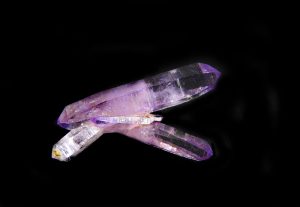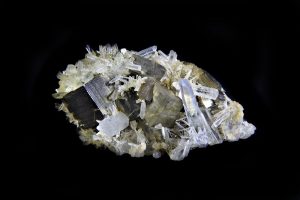
Knowing how to identify quartz is important when looking to add a variety of quartz to your collection. Quartz (SiO2) is a common silicate mineral. Other minerals in the silica group include chalcedony, opal, and garnet. Silicates make up a quarter of all known minerals with quartz being an important rock-forming mineral. Quartz is usually categorized as the second most prevalent mineral in the continental crust with feldspar listed as the most prevalent.

Quartz occurs in many forms in the crystalline and microcrystalline states. Both of these states contribute many specimens that are used to produce jewelry. Quartz can be found in most sites where minerals are found. Crystalline Quartz also known as rock crystal, or crystalline quartz has a Mohs hardness of seven which makes it attractive to the jewelry trade. On the Mohs scale, minerals can only be scratched by those with a higher number meaning quartz can only be scratched by minerals with a rating of eight (topaz), nine (corundum), or ten (diamond).
Rock crystal has a glasslike, or vitreous luster and occurs as water-clear crystals, purple, yellow, and other colors when it has certain inclusions. Quartz crystals form in the hexagonal system. Depending on the environment, they can form many variations. They can be doubly terminated, drusy gemstones, twinned, and can form scepters. They can even form irregular finger-like projections, as found in some Trancas geodes with crystals. Quartz crystals have a specific gravity of 2.7 and exhibit conchoidal fracture

Crystalline Quartz Uses
Crystalline Quartz uses include: jewelry, watches and clocks, heat-ray lamps, countertops, prisms and electrical equipment.
Healing Quartz
The word quartz comes from the German word quartz. In holistic practices, quartz is considered to be a powerful healing stone. It is thought to bring stability and harmony and aid in concentration. Quartz (SiO2) is a common silicate mineral. Other minerals in the silica group include chalcedony, opal, and garnet. Silicates make up a quarter of all known minerals with quartz being an important rock-forming mineral. Quartz is usually categorized as the second most prevalent mineral in the continental crust with feldspar listed as the most prevalent.
Quartz occurs in many forms in the crystalline and microcrystalline states. Both of these states contribute many specimens that are used to produce jewelry. Quartz can be found in most sites where minerals are found.

Courtesy Richard Gross
How to Identify Quartz – Properties
Also known as rock crystal, crystalline quartz has a Mohs hardness of seven which makes it attractive to the jewelry trade. On the Mohs scale, minerals can only be scratched by those with a higher number meaning quartz can only be scratched by minerals with a rating of eight (topaz), nine (corundum), or ten (diamond).
Rock crystal has a glasslike, or vitreous luster and occurs as water-clear crystals, purple, yellow, and other colors when it has certain inclusions. Quartz crystals form in the hexagonal system. Depending on the environment, they can form many variations. They can be doubly terminated, drusy, twinned, and can form scepters. They can even form irregular finger-like projections, as found in some Trancas geodes. Quartz crystals have a specific gravity of 2.7 and exhibit conchoidal fracture.
This story about how to identify quartz cutting previously appeared in Rock & Gem magazine. Click here to subscribe. Story by Richard Gross & Pam Freeman.













